Protocols in Noiseless and Noisy ChannelThe study of protocols is divided into two categories: those that can be applied to channels with no noise or errors and those that can be applied to channels with noise or errors. Although the first group of protocols cannot be applied in real-world situations, they provide a foundation for protocols for noisy channels. 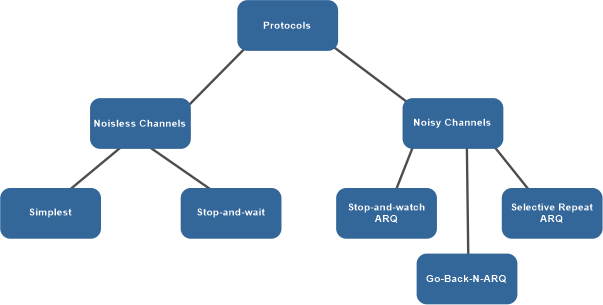
What is meant by a protocol?A protocol refers to a defined set of guidelines and regulations that control the communication between different devices in a network. These guidelines specify the way in which data is formatted, timed, sequenced, and checked for errors during transmission. Protocols play a crucial role in ensuring accurate, efficient, and clear communication between devices. They make it possible for devices of different types and brands to communicate with each other, and they provide a consistent method for transmitting data across a network. Headers are responsible for selecting protocols, which are rules governing communication between devices in a network. These headers contain information describing the message's nature and the handling it will receive. To detect any issues, the headers must include information such as the message's checksum, destination, and source addresses, and other necessary header addresses. The noiseless channel has the following two protocols:1. SIMPLEST Protocol - A simple protocol for a noiseless channel would be one that involves the direct transfer of data from the source to the destination without any intermediate processing. In this scenario, the channel is assumed to be noise-free, which means that the data transmitted remains intact and does not get corrupted. In a noiseless channel, a simple protocol could consist of a straightforward method for transmitting data, such as sending one bit at a time, with no error correction or flow control mechanisms in place. This type of protocol is ideal for a noiseless channel as the lack of noise ensures that the data transmitted is received accurately, making the implementation of additional measures unnecessary. The simplest protocol does not have any mechanisms for controlling the flow of data or detecting and correcting errors, as it is only used in noise-free channels. The protocol assumes that the receiver is always ready to process any data frames sent by the sender immediately. This type of protocol, which only allows data to flow from the sender to the receiver, is known as a one-way protocol. Since this protocol is unidirectional, there is no need for an acknowledgment or confirmation of receipt. Furthermore, because there is no data loss during transmission, there is no need to resend or retransmit the data. In order to create the simplest protocol, the following presumptions have been made:
Points to Remember:
In the absence of an ACK or NACK, the sender must wait a pre-determined time before transmitting the message. To solve this issue, a different protocol known as the Sliding Window Protocol is used. The sliding window protocol is a data connection layer protocol that allows for the sequential and reliable transmission of data frames. This protocol allows the sender to transmit multiple frames at once by utilizing sequence numbers. The sequence numbers are assigned to each data frame by the sender to ensure proper ordering in the event that a frame needs to be retransmitted. This also enables the receiver to detect lost or damaged packets. Note - An ACK (acknowledgment) is sent to the sender by the receiver after it has received the frame. The ACK informs the sender whether the recipient successfully received a specific frame. Go-Back-N ARQ and Selective Repeat ARQ are the two different kinds of sliding window techniques.Flow Diagram in Simplest Protocol: A data flow diagram (DFD) is a graphical representation of the flow of data in a system. In the context of the simplest protocol, a DFD can illustrate the movement of data between the sender and the receiver. The DFD would show how the sender sends the data frames to the receiver, how the receiver processes the data, and what happens if any errors occur during the transfer. It could also show the absence of flow control and error control mechanisms, which are typically included in more complex protocols. The DFD can help to clarify the basic functioning of the simplest protocol, making it easier to understand and implement. An illustration of a Stop-and-wait protocol-based exchange is shown in this figure. It's still simple to understand. Following the transmission of a frame, the sender awaits the receiver's answer. Send the following frame after waiting for the acknowledgment, or ACK, from the receiving end. Keep in mind that every time there are two frames, the sender is involved in four events and the receivers are involved in two events. 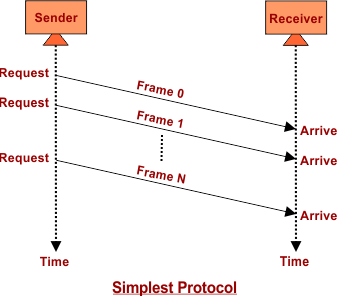
2. STOP-AND-WAIT Protocol - Stop and wait is a protocol that is used for reliable data transmission in a noiseless channel. In this protocol, the sender sends a single packet at a time and waits for an acknowledgment (ACK) from the receiver before sending the next packet. This way, the sender can ensure that each packet is received by the receiver and has been successfully processed. If the sender does not receive an ACK within a certain time frame, the packet is considered lost and must be retransmitted. The stop and wait protocol is simple and efficient, but it has one major drawback. Because only one packet can be transmitted at a time, the overall data transmission rate is relatively slow. To overcome this limitation, the sliding window protocol was developed. In the sliding window protocol, multiple packets can be transmitted at the same time, allowing for faster data transmission. Despite this limitation, the stop and wait protocol is still widely used in many applications due to its simplicity and reliability.
Flow Diagram The flow diagram of the Stop-and-wait protocol in a noiseless channel involves the following steps:
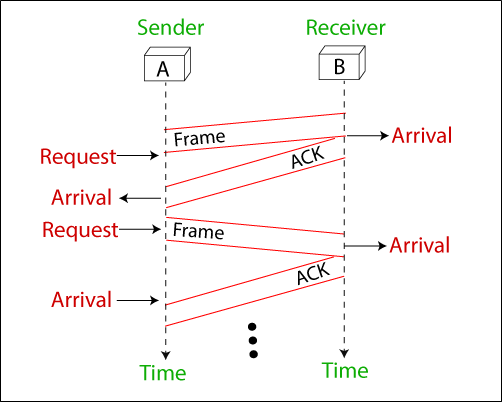
In this protocol, the sender sends one frame at a time and stops until it receives an ACK from the receiver. This prevents the receiver from becoming overwhelmed with incoming frames and ensures reliable data transmission. Additionally, the ACK frames are used for flow control, allowing the sender to adjust the transmission rate based on the receiver's processing capacity. CONCLUSION:The main difference between the two protocols is that the Simplest Protocol has no flow control and error control mechanisms, while the Stop-and-Wait Protocol employs a flow control mechanism through the use of ACK frames. In the Simplest Protocol, the recipient is always expected to be ready to receive any frames sent by the sender, so no acknowledgment is needed. In the Stop-and-Wait Protocol, the sender must wait for an acknowledgment from the receiver before sending the next frame. Another difference between the two protocols is that the Simplest Protocol is unidirectional, while the Stop-and-Wait Protocol is bi-directional. In the Simplest Protocol, data frames can only move in one direction, from sender to receiver, while in the Stop-and-Wait Protocol, both data frames and ACK frames can travel in both directions. In conclusion, the Simplest Protocol is a basic and straightforward protocol suitable for noiseless channels, while the Stop-and-Wait Protocol adds additional reliability through flow control mechanisms and is more suitable for noisy channels. Noisy Channel protocolsA Noisy Channel Protocol is a type of communication protocol that is used in communication systems where the transmission channel may introduce errors into the transmitted data. This type of protocol is designed to deal with errors in the communication channel and ensure that the data being transmitted is received accurately at the receiver end. The main objective of Noisy Channel Protocols is to minimize the error rate in the transmitted data by using techniques such as error detection and correction, flow control, and retransmission of lost or corrupted data frames. Some examples of Noisy Channel Protocols include the Stop-and-Wait Protocol, the Sliding Window Protocol, and the Automatic Repeat Request (ARQ) Protocol. 1. STOP-AND-WAIT ARQ Protocol - The Stop and Wait protocol is a protocol used for reliable data transmission over a noisy channel. In this protocol, the sender only sends one frame at a time and waits for an acknowledgment (ACK) from the receiver before sending the next frame. This helps to ensure that the receiver receives the data correctly and eliminates the need for retransmission in the case of errors caused by the noisy channel. The sender continuously monitors the channel for errors, and if an error is detected, it waits for the next ACK before resending the frame. This protocol adds error control to the basic unidirectional communication of data frames and ACK frames in the opposite direction. Flow Diagram A data flow diagram in the Stop-and-Wait protocol in a noisy channel can be used to describe the flow of data between the sender and the receiver. This diagram generally includes the following components:
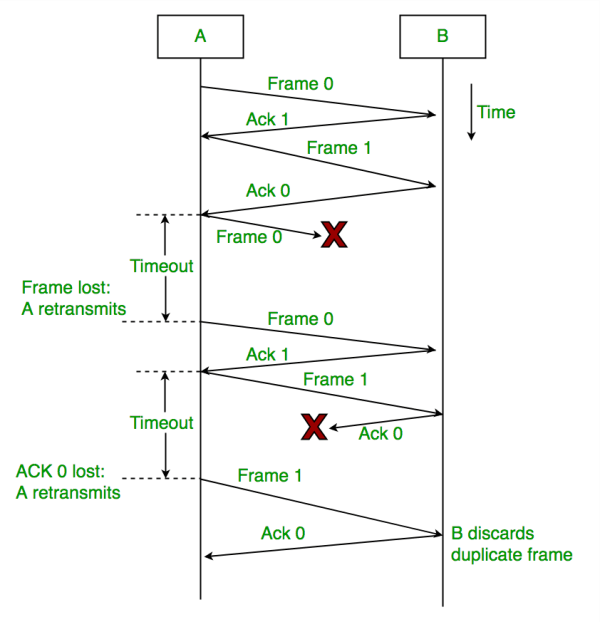
In this protocol, the sender only sends one data frame at a time and waits for a response from the receiver before sending the next frame. This ensures that the receiver has enough time to process each frame before receiving the next one. The Stop-and-Wait protocol is reliable, but has low throughput compared to other protocols. 2. GO-BACK-N ARQ Protocol - The Go-Back-N Automatic Repeat Request (ARQ) protocol is a type of error-control protocol used in data communication to ensure reliable delivery of data over a noisy channel. In a noisy channel, the probability of errors in the received packets is high, and hence, there is a need for a mechanism to detect and correct these errors. The Go-Back-N ARQ protocol is a type of sliding window protocol where the sender transmits a window of packets to the receiver, and the receiver sends back an acknowledgment (ACK) to the sender indicating successful receipt of the packets. In case the sender does not receive an ACK within a specified timeout period, it retransmits the entire window of packets. Flow Diagram The flow diagram that illustrates the operation of the Go-Back-N ARQ protocol in a noisy channel: 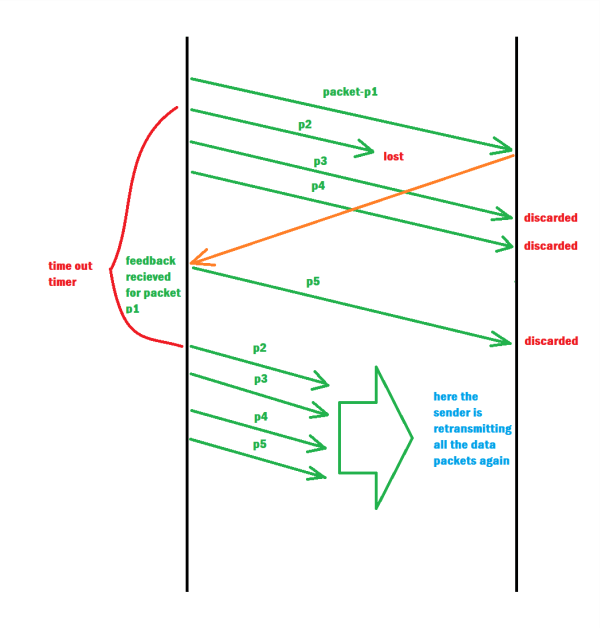
Sender Side:
Receiver Side:
Sender Side (in case of no ACK received):
Sender Side (in case of NAK received):
The above steps are repeated until all packets have been successfully received by the receiver. The Go-Back-N ARQ protocol provides a reliable mechanism for transmitting data over a noisy channel while minimizing the number of retransmissions required. 3. SELECTIVE REPEAT ARQ Protocol - The Selective Repeat ARQ protocol is a type of error-control protocol used in data communication to ensure reliable delivery of data over a noisy channel. Unlike the Go-Back-N ARQ protocol which retransmits the entire window of packets, the Selective Repeat ARQ protocol retransmits only the packets that were not correctly received. In the Selective Repeat ARQ protocol, the sender transmits a window of packets to the receiver, and the receiver sends back an acknowledgment (ACK) to the sender indicating successful receipt of the packets. If the receiver detects an error in a packet, it sends a negative acknowledgment (NAK) to the sender requesting retransmission of that packet. In the Selective Repeat ARQ protocol, the sender maintains a timer for each packet in the window. If the sender does not receive an ACK for a packet before its timer expires, the sender retransmits only that packet. At the receiver side, if a packet is received correctly, the receiver sends back an ACK with the sequence number of the next expected packet. However, if a packet is received with errors, the receiver discards the packet and sends back a NAK with the sequence number of the packet that needs to be retransmitted. Unlike Go-Back-N ARQ, in Selective Repeat ARQ, the receiver buffer is maintained for all packets that are not in sequence. When a packet with a sequence number different from the expected sequence number arrives at the receiver, it is buffered, and the receiver sends an ACK for the last in-order packet it has received. If a packet with a sequence number that the receiver has already buffered arrives, it is discarded, and the receiver sends an ACK for the last in-order packet it has received. In summary, the Selective Repeat ARQ protocol provides a reliable mechanism for transmitting data over a noisy channel while minimizing the number of retransmissions required. It retransmits only the packets that were not correctly received and buffers packets that arrive out of order to reduce the number of retransmissions required. Flow Diagram The flow diagram that illustrates the operation of the Selective Repeat ARQ protocol in a noisy channel: 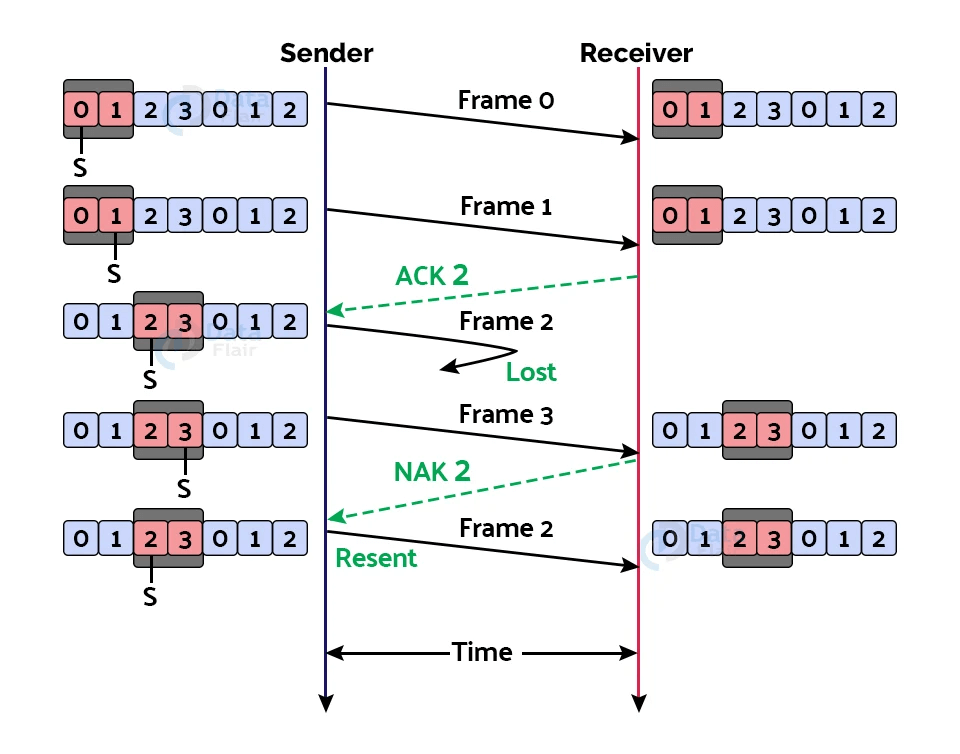
Sender Side:
Receiver Side:
Sender Side (in case of no ACK received):
Sender Side (in case of NAK received):
The above steps are repeated until all packets have been successfully received by the receiver. The Selective Repeat ARQ protocol provides a reliable mechanism for transmitting data over a noisy channel while minimizing the number of retransmissions required. It retransmits only the packets that were not correctly received, and buffers out-of-order packets to reduce the number of retransmissions required. CONCLUSION:A. Stop-and-Wait ARQ:
B. Go-Back-N ARQ:
C. Selective Repeat ARQ:
In summary, Stop-and-Wait ARQ is the simplest and most reliable protocol but not suitable for high data rates. Go-Back-N ARQ is suitable for channels with moderate to high error rates, and Selective Repeat ARQ is suitable for high data rates and long transmission distances. The choice of protocol depends on the characteristics of the communication channel and the requirements of the application. |
 For Videos Join Our Youtube Channel: Join Now
For Videos Join Our Youtube Channel: Join Now
Feedback
- Send your Feedback to [email protected]
Help Others, Please Share









